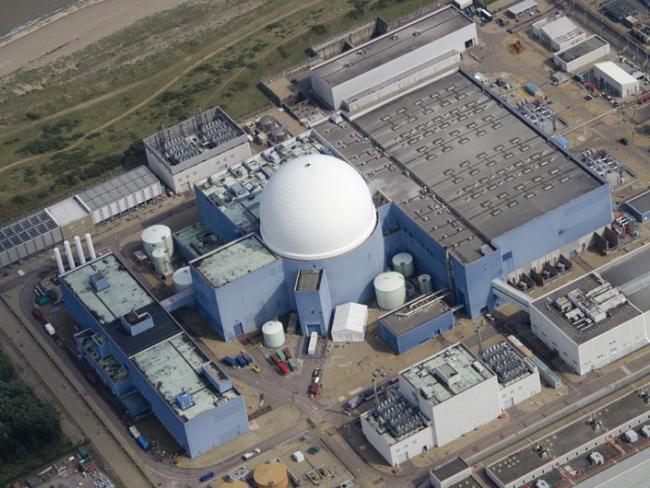
Sizewell B nuclear station, on the Suffolk Coast. Photo John Fielding, via Wikipedia (CC BY 2.0).
A new book sets out the case for nuclear power as the key energy source and the consequences of ignoring its potential…
Going nuclear: how the atom will save the world, by Tim Gregory, hardback, 384 pages, ISBN 978-1847928078, Bodley Head, 2025, £25. Kindle and eBook editions available; paperback due out June 2026.
Tim Gregory is a nuclear chemist at the United Kingdom National Nuclear Laboratory at Sellafield. He aims to show how nuclear power is the only way we can decarbonise our world while sustaining economic growth, protecting the environment, and continuing the progress of the past century.
The 2023 COP28 climate conference recognised the “key role of nuclear energy in achieving global net zero.” It included a commitment to developing and building small nuclear reactors.
To reach net zero, we need emissions-free sources of electricity. Nuclear power is emissions-free. To reach net zero while having reliable energy sources, we need sources of electricity that are dependable, potent, and available 24/7. Nuclear power fits the bill.
By contrast, the alternatives prove to be neither very alternative nor very emissions-free. Gregory points out that electric cars don’t reduce net emissions. While they’re zero-emissions on the road, and aggressively marketed as such, electric cars are only really zero-emissions if the electricity that charges them is generated emission-free – which it isn’t.
In other words, charging cars with electricity generated with fossil fuels replaces the internal combustion engine with an external combustion engine.
Rock solid
In 2024, the Breakthrough Institute assessed the amount of rock that needs to be mined to generate a gigawatt-hour of electricity from different sources. Coal is by far the most mining-intensive. Wind-power needs 160 to 340 per cent more rock to be mined than nuclear power does, and solar power needs 240 per cent more than nuclear power.
Nearly 60 per cent of all the electricity Germany has generated since 2000 came from fossil fuel-fired power stations. For France, 9.6 per cent. That’s because Germany snubbed nuclear and France embraced it. In 1974, France started the biggest rollout of nuclear power that any nation had – and has since – undertaken. It built 54 pressurised water reactors in 25 years. All still work, and French households pay less for their electricity than the EU average.
France doesn’t have its own uranium reserves, so since 1987 it has been making its own recycled uranium. It turns the major component of spent fuel, enriched uranium, into fresh nuclear fuel rods. 95 per cent of its spent fuel is recycled.
France has stored 34,000 tonnes of recycled uranium so far; this contains as much energy as 490 million tonnes of coal or 2.3 trillion barrels of oil. This stockpile, if burned in a Canada deuterium uranium reactor, could power it for 680 years. France has made this recycling economical. It adds less than one euro a month to the average household electricity bill.
Recycling
Britain could recycle its 141 tonnes stockpile of “waste” plutonium to power six to ten breeder reactors, each able to produce 1,000 megawatts of electricity. There’s enough plutonium to power the two new reactors at Hinkley Point C – which will generate the electricity to meet the needs of three million people every year – until 2120. We could double our current nuclear capacity by burning this nuclear waste.
But successive governments have classified this plutonium as a “zero value asset”. In 2024 the Sunak government announced that it wouldn’t be using the plutonium to power its new fleet of reactors. Then this year the Labour government announced that the plutonium will be buried. All that latent emissions-free energy wasted, put out of reach.
Gregory examines the much-publicised “nuclear disasters” at Chernobyl and Fukushima. Of those directly involved with the accident at Chernobyl, fewer than 40 people died. Later, there were also 15 thyroid cancer deaths. Not the 57,000 deaths forecast by the Union of Concerned Scientists! And HBO falsely claimed in its 2019 Chernobyl TV miniseries that “there was a dramatic spike in cancer rates across Ukraine and Belarus.”
‘To reach net zero, we need emissions-free sources of electricity. Nuclear power is emissions-free…’
Fukushima’s confirmed direct death toll was one. What about later deaths among members of the public? There aren’t any. In 2022, the UN Scientific Committee on the Effects of Atomic Radiation summed up eleven years of Fukushima research. It found no evidence that radiation had caused any adverse health effects at all, even among those who lived close to the power station. But 2,300 people died of stress, caused by the botched evacuation.
The Japanese government responded foolishly by closing down all its nuclear power stations, instead relying on fossil fuels, including coal. The result? An extra 10,000 to 27,000 air pollution deaths between 2011 and 2017.
Japan has no coal or gas, so relies heavily on imports, which makes fossil fuels expensive. The government put the costs of replacing nuclear power onto bill-payers, making electricity unaffordable for many. People were forced to switch off their electric heating units to save money, and in the three years after the accident 4,500 people died from the cold.
The Merkel government in Germany, nearly 6,000 miles away from the nearest tsunami, reacted in the same way with similar results. Air pollution from coal killed an estimated 5,600 people between 2011 and 2019.
Gregory concludes, “Building nuclear power stations and circularising their fuel cycles with breeder reactors – starting now, and in earnest – is the single biggest environmental step we could take. It’s the way we’ll power the world – cleanly and reliably – far beyond our net zero deadlines; carbon dioxide doesn’t enter the nuclear equation.”
